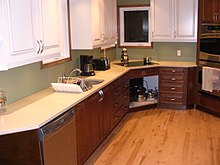Engineered stone: Difference between revisions
| Line 35: | Line 35: | ||
*[http://homeguide123.com/videos/Engineered_Stone_Countertops_Video.html Engineered Stone Countertops Video] |
*[http://homeguide123.com/videos/Engineered_Stone_Countertops_Video.html Engineered Stone Countertops Video] |
||
*[http://www.taunton.com/inspiredhouse/pages/ih00001_05.asp Pros, Cons, and Cost of Engineered Stone] |
*[http://www.taunton.com/inspiredhouse/pages/ih00001_05.asp Pros, Cons, and Cost of Engineered Stone] |
||
*[http://www.imexstone.net/granite-countertops-fort-myers.html Read more about Countertops ] |
|||
[[Category:Kitchen countertops]] |
[[Category:Kitchen countertops]] |
||
Revision as of 07:52, 5 September 2012
Engineered stone is a composite material made of crushed stone bound together by a polymer resin. It is used primarily for kitchen countertops. Related materials include geopolymers and cast stone. Unlike terrazzo, the material is factory made in slabs, cut and polished by fabricators, and assembled at the worksite.
Engineered stone products are gaining in popularity and are sometimes preferred over granite products because engineered stone requires less maintenance. Compared to unsealed granite, it has better resistance to stains.[1] However, recent research reported in Consumer Reports magazine reveals virtually no difference in performance between quartz products and sealed granite.[2]

Engineered stone is also commonly referred to as agglomerate or 'quartz surface', though it is possible to create solid surface using fillers other than quartz. [3]
Manufacturing Equipment
Breton S.P.A, a privately held company of Treviso Italy, is the dominant supplier of equipment for making engineered stone. A mixture of 93% quartz and 7% polyester resin is pressed into slabs (or larger blocks) using Breton's "vibrocompression vacuum process". [4] [5]
Although Breton was the original manufacturer of slab moulding equipment, there are now several other companies producing similar machinery. The Chinese company Keda Stone Machinery[6] being one of the largest.
China is currently the biggest market for new slab producing machines. There is estimated to be more than 100 engineered stone suppliers in China alone.
Composition
Quartz is the major filler, although other material like coloured glass, shells, metals, or mirrors might be added. A typical material will consist of 93% quartz by weight and 7% resin. Different types of resins are used by different manufacturers. Epoxy and polyester resin are the most common types. Chemicals such as UV absorbers and stabilizers are added. To aid curing, peroxide is added.
Properties
Engineered stone is typically worked in the same way as natural stone using a water jet cutter or a diamond blade. This is in contrast with solid surface materials which can be cut with regular saws.[7]
The material can be produced in either 12 mm, 20 mm or 30 mm thicknesses. The most common slab format is 3040 mm x 1440 mm, but other sizes like 3040 mm x 1650 mm are produced according to market demand.
Engineered stone is typically stronger in flexibility and hardness, and less porous, than natural stone, but not in all cases. Less porous varieties are more resistant to mould and mildew then traditional stone[8]. It is typically uniform in structure leading to inherent strength, whereas natural stone may by-nature contain fissures, cracks, or weaknesses in structure. Its polyester resin binding agents allow some flexibility, preventing cracking under flexural pressure. But, the binding agents often continue to harden, leading to a loss of flexural strength over time. The polyester resins are not completely UV stable and engineered stone should not be used in outdoor applications. Continuous exposure to UV can cause discoloration of the stone, and breakdown of the resin binder. The material is damaged by direct application of heat, and should not be used close to a direct source of ignition.
See also
References
- ^ Engineered Stone Deserves a Hard, Hard Look HGTV.com Retrieved November 2, 2007.
- ^ Countertops: Our tests reveal the looks that last consumerreports.org Retrieved January 2, 2010.
- ^ http://stonebusinesseditor.wordpress.com/2010/03/22/name-that-whatever
- ^ http://www.sitesnsolutions.com/Articles/History%20of%20Breton%20Process.htm
- ^ http://www.breton.it/dynamic/en/catalogo/schedaProdotto.php?id=128&
- ^ http://www.kedagroup.com
- ^ Patrick Spielman, The New Scroll Saw Handbook,Sterling Publishing Company, Inc., 2002 ISBN 0-8069-7877-5 page 298
- ^ "Bathroom Vanities". Retrieved 21-06-2012.
{{cite web}}: Check date values in:|accessdate=(help)
